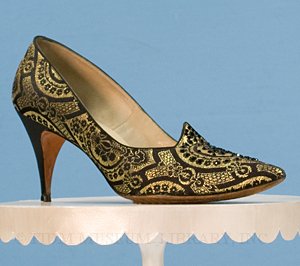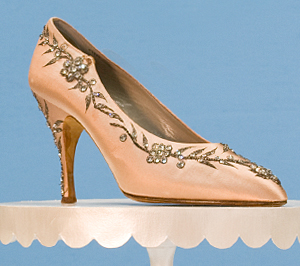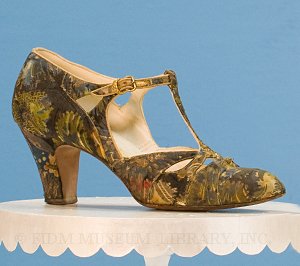Brocade T-Strap Evening Pump
Woodward & Lothrop
c. 1927
Silk brocade, leather, rhinestone and metal
Gift of Vicky Stevenson
S2008.948.2A/B
During the 1920s and into the 1930s, T-strap shoes were popular for both day and evening wear. This muli-colored, floral patterned silk brocade T-strap evening shoe dates from about 1927. Silk shoes were most commonly worn indoors, as the delicate fabric would have easily stained or torn when walking about on city streets. The insole is marked with a gold stamp reading “Woodward & Lothrop,” a now-defunct department store based in Washington D.C. With its gold and yellow rhinestone buckle and yellow accented floral pattern, this shoe would have perfectly complemented the short, slim, jewel-toned evening dresses of velvet or silk popular in the mid-1920s. Metallic accents, like the yellow-gold tone in the pattern and the rhinestone buckle, were popular in 1920s evening dress and accessories. The sturdy boulevard heel would have allowed the wearer of these shoes to easily dance the Charleston, one of the trademark dances of the 1920s.

Macramé Evening Sandal
Bullock's Wilshire
c. 1933
Cotton, metallic leather, rhinestones
Gift of Beverly Roberts
2000.958.1A/B
This shoe was part of a handmade pair purchased around 1933 at Bullock’s Wilshire, a defunct Los Angeles department store. As a luxury department store, Bullock’s Wilshire catered to many Hollywood stars. During the 1930s, it was these same stars whose glamorous on-screen costumes set the styles for women throughout the country. Evening wear was particularly show-stopping, with glamorous bias cut gowns of silk favored. When paired with a bias cut gown, these open weave metallic pumps would have added a final touch of luxury.
Woven shoes were popular in the mid to late 1930s. Fashion writers sometimes called these “skeleton” shoes because the open weave was thought to resemble the structure of a human skeleton. As exposing the foot was considered risqué before about 1930, the skeleton shoe was an exciting new possibility. It was popular for both day and evening footwear.

Brocade Evening Pump
Saks 5th Avenue
c. 1958
Silk and metallic brocade, leather, plastic
Gift of Mrs. Carita Kadison
2003.792.11A/B
Dating from about 1958, the black and gold brocade evening pump seen in the center bears a Saks Fifth Avenue label. With its extremely pointed heel, it is a classic example of the needle stiletto. So called because of its sharply tapering heel, the needle stiletto was just one of many variations on the popular 1950s stiletto heel. Note the difference between this extremely narrow heel and the much thicker boulevard heel pictured on the silk brocade c. 1927 shoe. The exuberant black and gold silk brocade suggests the psychedelic prints that would become widely popular in the 1960s.

Satin and Rhinestone Evening Pump
Worn by Marlene Dietrich
Roger Vivier for Christian Dior
c. 1950-1959
Silk satin, rhinestones, leather
Department of Recreation and Parks, City of Los Angeles, FIDM Museum
Created by Roger Vivier for Christian Dior and worn by Marlene Dietrich, the 1950s pale-pink silk satin evening pump seen in the center was created by an icon and worn by an icon. Vivier worked with Dior from 1953-1963, creating some of the most fabulous shoes of the 20th century. These shoes were often dripping with feathers, beads or the rhinestones seen here. Both the shape and embellishment of Vivier’s shoes were very influential, resulting in copies at all price points. Vivier often played with the heel shape in his shoes, though he is most closely associated with the stiletto heel. This particular pair of Vivier high heels once belonged to the personal wardrobe of Marlene Dietrich, siren of the silver screen. Dietrich stared in The Blue Angel (1930), Desire (1936) and A Foreign Affair (1948), among others.



Oh, but to have wee little feet with lovely arches to put in these fabulous shoes! I love them all!